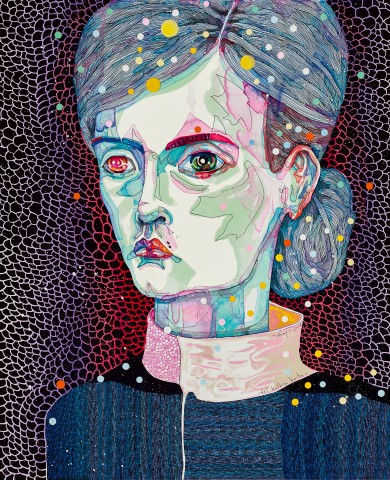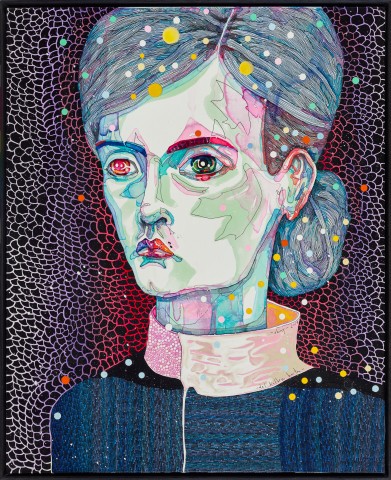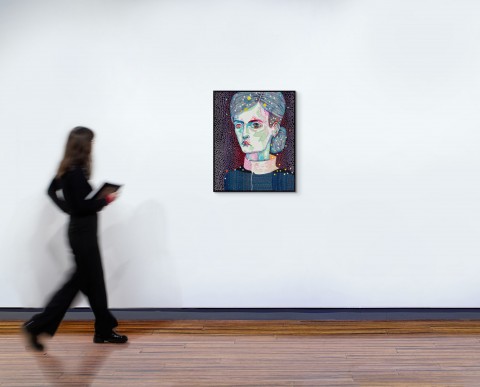SHINY, 2014
DEL KATHRYN BARTON
synthetic polymer paint on linen
81.0 x 66.0 cm
signed, dated and inscribed with title lower right: -shiny-2014 / -del kathryn barton-
signed, dated and inscribed with title verso: del kathryn barton 2014 / title – shiny
Roslyn Oxley9 Gallery, Sydney (label attached verso)
Private collection, Sydney, acquired from the above
Del Kathryn Barton, electro orchid, Roslyn Oxley9 Gallery, Sydney, 13 November – 13 December 2014, cat.7 (illus. in exhibition catalogue)
Del Kathryn Barton: The Highway is a Disco, National Gallery of Victoria, Melbourne, 17 November 2017 – 12 March 2018
Wallis, P. and Frew, P., Del Kathryn Barton: The Highway is a Disco, National Gallery of Victoria, Melbourne, 2017, pp. 3, 31 (illus.), 119
Leading Australian contemporary artist, Del Kathryn Barton has risen to critical and public acclaim on the strength of her portraiture, depicting for the Archibald Prize popular celebrities such as Hugo Weaving and Cate Blanchett, but also herself, flanked by her children. In parallel to these memorable prize-winning portraits, Barton has interspersed smaller scale portraiture within her studio practice, creating an on-going series of portraits of anonymous and androgynous figures, alike in treatment and appearance and progressively incorporating new aesthetic decisions as Barton’s career advances. Placed in front of a patterned screen, the pale figure of Shiny is luminescent, and like her many siblings each in their own frames, is statically transfixed in a contemplative state. As the title of this painting suggests, Barton’s carefully crafted universe is ultimately one of sensation, of surface effects of colour and texture - creating finished products of overwhelming exuberance.
Protected behind a veil of multicoloured dots and bearing an indecipherable expression, the subject of Shiny, although human-like in appearance, does not invite empathy or interaction with the viewer. While she is not endowed with wings or multiple limbs, her other-worldly power is hidden within swirling galactic eyes and elfin features. These sharp contours are almost identical to those of her companions, chiselled nose and pouting red lips echoing those of her neighbours in the suite. In reprising for the background a graduated red, purple and white web pattern from another accompanying painting of the same year, Mother Web, Barton alludes to a menacing, occult power wielded by her inconspicuous subject.
Tightly cropped to display only the head and shoulders, positioned in an upright three-quarter profile, Barton’s mature and regal portraits draw their inspiration from the format of High Renaissance portraiture of the elite classes. A mainstay of Barton’s practice since 2009, these portraits have supplanted her earlier vulnerable paintings of girls – the ethereal females of this phantasmagorical universe ageing alongside their artist creator. The uniformity of their composition allows Barton to explore surface and decorative variations, indulging in her distinctive sumptuous and obsessive patterning.
Although now working across many varied media, the intricate and meditative act of drawing still underpins all of Barton’s work. Raw and instinctual, her wandering inky lines trace spindly fingers and angular features and the outer edges of delicately modulated liquid shadows in pink and blue. Arranged in contrasting vertical and horizontal stripes, however, the minute dotting of this woman’s clothing bristles with imposed and contained order. And, although glowing with multicoloured hues and painstakingly drawn, her flowing locks of hair are also flattened, swept up in a neat bun. Even the structure of her turtleneck outfit projects an appearance of contained rigidity from which the profusion of patterning and colour threatens to break free, the pearlescent paint dripping neatly down the centre of the canvas.
As Julie Ewington has noted, the figures in Barton’s paintings ‘are always gazing either out of the canvas at the viewer or scanning their world’, there is ‘an insistence on watchfulness.’1 Staring blankly into the distance, her oversized coloured eyes look both inward and outward, voyaging beyond the mundane towards a cosmic realm. She is transfixed, awestruck by an unknowable plane of consciousness, one unblinking eye swirling with enchantment while the other stares directly out to the viewer.
1. Ewington, J., Del Kathryn Barton, Piper Press, Sydney, 2014, pp. 37, 47
LUCIE REEVES-SMITH


